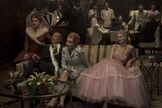I'm honored to be the first Chinese-American actress to win an Oscar, not as a yellow or oriental caricature, but as a woman, a complex woman with a heart and soul.
In Netflix's new drama "Hollywood," Murphy used new-historical revisionism to speak for the marginalized in Hollywood, and Chinese-American Hollywood actress Anna May Wong won the 1953 Academy Award for Best Supporting Actress for her fictional film "The Meg."
However, in real history, Chinese women in Hollywood movies are the imagination of others conveyed by the United States in the world discourse order with Western modernity as the core, and have distinct ideological characteristics of imperialism and colonialism. Hollywood establishes a relationship of domination and domination between men and women in the binary opposition of the West and the East, demonstrating the racial and cultural superiority of the West over the East. The images of Chinese women displayed are either beautiful and enchanting, which are extremely tempting; or barbaric, ignorant, and evil, satisfying the curiosity and desire to conquer China in American society. Under the discourse order of Orientalism, Hollywood established the absolute high position of the West in sexuality, race and politics through the "feminine" description of China.
1. Orientalism and Hollywood Films
Said, a famous critic, pointed out that Orientalism is "a way of thinking based on the ontological and epistemological distinction between the East and the West. , desires and attempts to annex Eastern countries". It is not a real discourse about the East, but a projection and reflection of Western rights, desires, values, ideologies. In the world discourse order with Western modernity as the core, the opposition between the West and the East means a series of oppositions, such as modern and ancient, civilization and barbarism, progress and backwardness, democracy and autocracy, science and superstition, rationality and ignorance. Western countries center on their own values and rights order, deliberately depreciate and marginalize other cultures, and establish and consolidate their own dominant and hegemonic positions.
By portraying savage, ignorant, and degenerate Chinese women, Hollywood films have constructed the image of a decadent and decadent China in the eyes of Americans. Chinese women in Hollywood films are usually charming, sexy, naked, and exotic, fully satisfying the curiosity of the American public about China. The docility and tameness of Chinese women reflects the conceit of the United States and the so-called advanced nature and superiority of Western culture, which instills the idea that it is an inevitable trend for Western culture to replace Eastern culture.
2. The image of Chinese women in early Hollywood films
It has been more than 100 years since Hollywood movies have shaped the image of Chinese women, and they have experienced the evolution from negative to positive, negative to positive, polarized to diversified, stereotyped to full, and stylized to individualized. The early stage mainly includes the following character types: Lady Butterfly, Prostitute, Dragon Girl, Nora, Spider Girl, Concubine, Princess, Mother Earth, etc.
(1) Early 20th century to 1949: polarized images of women
During this period, two extreme Chinese female images appeared in Hollywood films: one was charming, docile and docile; the other was savage, evil, ferocious, and debauched. The former are often reduced to sexual tools for Western men, while the latter are on the road to self-destruction. At this time, female characters are mostly supporting roles, and the roles are single. They usually wear heavy makeup, revealing sensuality, and wear exaggerated costumes, full of exoticism and sexual allure. These stereotyped and abstract female images are American society's imagination of the East to satisfy its possessiveness and sense of superiority to the East.
Hollywood's "Red Lantern" in 1919 brought Chinese female images to the big screen for the first time. Anna May Wong's mistress character is beautiful and coquettish, servile to white men, and does everything in her power to please. Since then, the Chinese women who appeared in the films were mostly prostitutes, mistresses, and concubines. They often had bare skin, mysterious and strange clothes, seductive and lewd temperaments, full of sexual temptation, and became sexual tools for men.
Another type of role that Anna May Wong often plays is the Chinese version of Madame Butterfly—a pure Chinese girl willing to sacrifice for a white man. The masterpiece of this type is "The Sea Gone" (1922): a gentle and beautiful Chinese female lotus by the sea Rescue and fall in love with the young American Karen. When Karen left her, she was pregnant. A few years later, Karen returned to China with his white wife. Lotus did not appeal and defend her love, but entrusted the child to Karen and his wife, telling the child, "I'm just your Chinese nanny, this is yours. American Mom", then jumped into the sea to commit suicide. Whether it is the child's pure Western appearance or Lotus' renunciation of mother's rights, the essence is a complete denial of Chinese culture. And those Chinese women who are not tamed are often portrayed as evil witches.
"Dragon Girl" (1931) portrays the savage, sinister and vicious Princess Ling, wearing a high feather hat and revealing soft armor, the silhouette projected on the wall is just a ferocious dragon. As one of the "Fu Manchu" series of films, "Dragon Girl" is also the personification of the "Yellow Peril". She seduces men with her beauty and makes waves in the white world. For white men, she is full of temptation, but also extremely dangerous, so she cannot escape the fate of death.
The role models of "Dragon Girl" and "Butterfly" have strong inertia, and their traces can still be found in Chinese female characters in Hollywood films until today, so that those Chinese actresses who want to gain a foothold in Hollywood must either be skillful , to be able to play the role of "playing women", or must have a sexy appearance.
(2) 1949 to 1980s: Consumed, Abandoned and Conquered Female Images
Beginning in the 1940s, especially after the founding of New China in 1949, Chinese female characters gradually occupied a relatively important position in Hollywood films, or were portrayed positively, but they usually became the prey of Western males and could not escape being consumed and abused. Abandoned and conquered destiny. Hollywood uses the female body to construct an imaginary East, and through the conquest of the Chinese female body by white men, it conveys the Orientalist discourse of the West conquering the East.
In "Shanghai Express" (1940), the glamorous and arrogant Shanghai courtesan Lily and the British young Harry are obsessed with him after breaking up, and in order to save him, he committed himself to the warlord. King Jin in Shanghai Posture (1942) is an oriental noblewoman with enormous power who rules the underground casinos in Shanghai, but she cannot escape being abandoned by white people. Han Suyin in "Life and Death" (1955) is a new Chinese woman with a good British education. She works in the best hospital in Hong Kong and has three suitors from China, the United Kingdom and the United States, but she ends up marrying an American journalist White, alluding to America's territorial conquest of Hong Kong.
"Taipan" (1986) tells the story of the complicated battle between the British merchant leader Stuart (known as Taipan), who was doing business in Guangzhou and Hong Kong, and other merchants and the Qing court in the last years of the Qing Dynasty, and finally won the business war and joined hands with the story of the beauty. Taipan's wife, Meiwei, is beautiful, gentle, obedient, and cowardly, with typical Chinese female image characteristics. However, in this kind of relationship where the status is completely passive and can only be depended on, Meiwei is also fighting through her own efforts to seek the status of an official wife, not just waiting for the charity of the Taipan. Mei Wei was especially jealous when she knew that Tai Pan liked a white lady, and asked Tai Pan, "Why can I only do housework at home day after day without seeing people?" I hope that I can be led by the big class to participate in the dance and become a member of social occasions. Taipan was shocked after seeing it. The surprise contained reprimands, dissatisfaction and praise. This surprise also completely dispelled Meiwei's desire to enter social situations. She "just wanted to wear it for you (Taipan)". Meiwei later changed her strategy and faced the big class as a servant. More extreme, she is even willing to enjoy the process of masochism to express her infinite dependence on Taipan. However, the film shows that Mei Wei's willingness to be a maid was voluntarily, and she even forced Tai Pan to "abuse" her. Even if Tai Pan beat her, she was just pretending to show it to outsiders. She told Taipan that polygamy is a normal phenomenon in China. The implication is that Meiwei does not insist on being the only wife of Taipan. It was this kind of absolute obedience and consideration that satisfied Taipan's imagination of oriental women. Later, Taipan willingly "entitled" Meiwei as his wife, a monogamous wife. Meiwei went from directly fighting for a legal identity in public, to serving the big class at home with her "curve to save the country", and finally becoming the only wife in the house. It is worth mentioning that "the mainstream media in the United States, such as "Time" Weekly, when reporting on Chen Chong's role as Mei Wei in "The Tai Pan", sensationally exaggerated 'China's most popular female star, who was once a woman in a Chinese revolutionary film. Heroes, now playing the most decadent and depraved foreign slaves', this is the victory of 'bourgeois spiritual pollution'."
3. Interpretation of the reasons for the evolution of Chinese women's images
The images of Chinese women in early Hollywood films were mostly sexy and charming mistresses, prostitutes, and concubines attached to men. This is not only the fantasy of Western men on Chinese women, but also the mirror image of American society on China, which has profound social and cultural reasons.
China before 1949 was a vague vision for Hollywood. Although Western countries began to understand China's ancient civilization as early as the Yuan Dynasty, the West really began to understand China and form a national image cognition from the Opium War. In a series of wars of aggression against China, Westerners linked China to declining empires and inferior nations. To the American public, China on the screen is a savage, backward oriental landscape. In The Passing of the Sea, China is a graceful silhouette of the coast, reefs, gardens, benches under camellia trees. No one cares whether it looks like China or not, it is just an altar where oriental girls unilaterally make sacrifices and sacrifices. In "Dragon Girl", China is condensed into Fu Manchu's father and daughter's apartment in California, with proud dragon totems hanging on the walls, huge ceramic vases adorned in the corners, and candlestick incense cases carefully placed on the walls. It was a dark, closed, pagan space isolated from the bright and rational world of white people. These spaces are relatively static in the temporal dimension, suspended outside the dynamic and ever-evolving Western world. Lianhua and Fu Manchu's daughter are a still silhouette, not in history, more precisely in the history of the West, only when they have contact with white males, whether flattering or antagonistic. It reflects its own value and significance, acquires the ability to act, and has the opportunity to enter the historical narrative.
4. Conclusion
Early Hollywood films demeaned Chinese culture by portraying marginalized women. But since the 1980s, Hollywood has gradually gained a diverse perspective on China, and the orientalist imagination is fading out of the audience's field of vision. China is regarded as an indistinguishable existence in the globalized landscape, and "Chinese themes" have also been requisitioned by Hollywood, and released films such as "Mulan" and "Crouching Tiger, Hidden Dragon". Women such as Mulan, Yu Xiulian and Yu Jiaolong The image is deeply rooted. But in recent years, the "Crazy Rich Asians fever" is not difficult to see the trend of Hollywood implanting its values by shaping Westernized Chinese women. In the future, where China will go for Hollywood movies, more excellent Chinese directors are needed to find a balance between universal values and national values.
View more about Hollywood reviews











